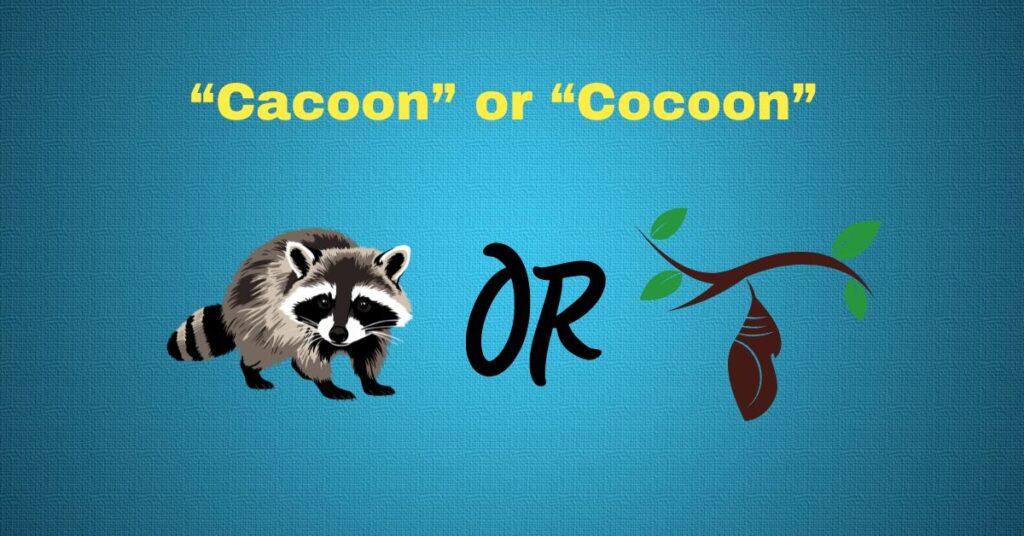Have you ever found yourself wondering whether “cacoon” or “cocoon” is the correct spelling? You’re not alone! Many people confuse these two terms, and while they sound similar, only one of them is accurate. In this article, we will break down the correct spelling, explain the meaning of “cocoon,” and show you how to use it properly in various contexts. Whether you’re writing a story, an academic paper, or just aiming to improve your language skills, understanding the proper spelling is key. Let’s dive in and clear up any confusion!
Definition
- Cocoon refers to a silk case created by insects like caterpillars during their pupal stage. This structure serves as a protective covering while the insect undergoes metamorphosis into its adult form, such as a moth or butterfly. The word “cocoon” comes from the French term cocon, meaning “small shell.”
- Cacoon is simply a misspelling of “cocoon” and does not have any recognized meaning in English. It’s a common error but does not appear in any formal dictionary or usage guide.
Meaning & Explanation
What Does “Cocoon” Really Mean?
At its core, a cocoon is a protective, silk-covered shelter spun by an insect as part of its metamorphosis process. Think of it as a temporary home that shields the insect while it transforms into its adult form. Moths, butterflies, and other insects create these cocoons, which are often found hanging on branches, tucked away in crevices, or buried in the ground.
The term has extended beyond its biological meaning. Metaphorically, a “cocoon” can describe any place or state where someone feels safe, protected, or isolated. Imagine a busy professional retreating to their cozy apartment, away from the stress of work. In this case, the apartment becomes their “cocoon”—a space where they can rejuvenate and feel secure.
Key Takeaways:
- Literal meaning: A protective case spun by insects during metamorphosis.
- Metaphorical meaning: A safe, protective, or isolating environment.
Examples & Usage
Let’s look at how “cocoon” is used in different contexts:
- Literal (insect-related):
“The caterpillar spun a cocoon around itself, preparing for its metamorphosis into a butterfly.” - Metaphorical (protection or isolation):
“After a hectic week of meetings, Sarah retreated to her home, a cocoon of tranquility where she could unwind.” - Figurative (emotional or social isolation):
“Feeling overwhelmed, he built a mental cocoon around himself, avoiding social events to recharge.”
These examples highlight the versatility of “cocoon.” It’s not just an insect’s protective shell but can also represent physical or emotional protection in everyday life.
Types & Categories
While the word “cocoon” is most commonly associated with moths and butterflies, there are various types and categories of cocoons:
| Type | Description |
| Moth Cocoon | Typically made of silk, moth cocoons are created by moths during their pupal stage. |
| Butterfly Chrysalis | Unlike moths, butterflies form a hard casing called a chrysalis, not a silk cocoon. |
| Figurative Cocoon | Any place or situation where someone feels safe, isolated, or protected, like a personal retreat. |
Understanding these types helps clarify the broader use of “cocoon” in both nature and metaphor.
Related Words & Synonyms
Here are some related words and synonyms that offer further insight into the concept of “cocoon”:
- Chrysalis: The pupa stage of a butterfly, often confused with a cocoon but different in structure.
- Pupa: The life stage of an insect that occurs between larvae and adult, often enclosed in a cocoon or chrysalis.
- Larvae: The juvenile form of insects, which eventually become pupas and later adults.
- Enclosure: A term for a protected area or space, similar to a cocoon.
- Shell: A hard, protective outer covering that can symbolize safety or defense.
FAQ Section
Let’s clear up some frequently asked questions about the word “cocoon.”
Q1: Is “cacoon” a real word?
- No, “cacoon” is a misspelling of “cocoon.” It has no accepted meaning in English.
Q2: What is the difference between a cocoon and a chrysalis?
- A cocoon is spun by moths and made of silk, whereas a chrysalis is a hard casing formed by butterflies. Both serve as protective coverings during metamorphosis.
Q3: Can “cocoon” be used metaphorically?
- Yes! “Cocoon” is often used metaphorically to describe a place or situation where someone feels safe, protected, or isolated, like a personal retreat from the world.
Q4: How can I remember the correct spelling of “cocoon”?
- One helpful trick is to picture the double “o” in “cocoon” as representing the rounded shape of the cocoon itself.
Conclusion
In conclusion, the correct spelling is “cocoon”, not “cacoon.” Whether you’re referring to the protective silk case of a caterpillar or using the word metaphorically to describe a place of comfort and safety, remembering the right spelling is essential for clear and professional writing.
Key Takeaways:
- “Cocoon” is the correct spelling.
- It has both literal (insects) and metaphorical (protection) meanings.
- Pay attention to spelling to avoid common errors like “cacoon.”
With these tips, you’re now ready to use “cocoon” confidently in your writing!
Excell or Excel What Is the Correct Spelling?






